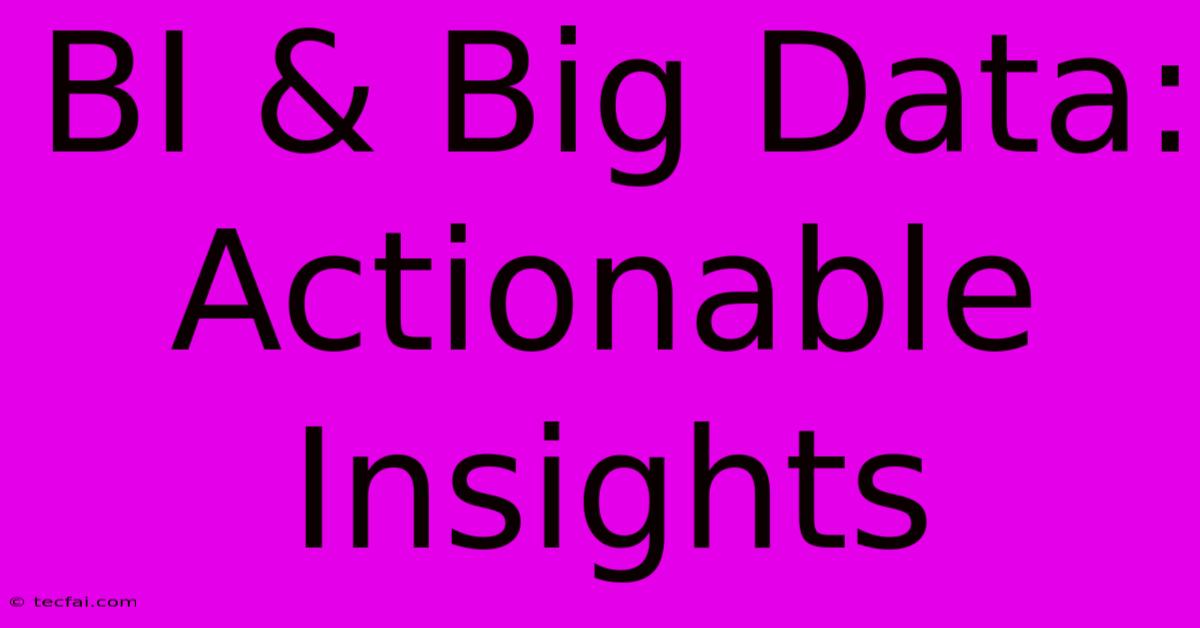BI & Big Data: Actionable Insights

Discover more detailed and exciting information on our website. Click the link below to start your adventure: Visit Best Website tecfai.com. Don't miss out!
Table of Contents
BI & Big Data: Actionable Insights for Smarter Business Decisions
In today's rapidly evolving business landscape, the ability to extract actionable insights from data is no longer a luxury but a necessity. The convergence of Business Intelligence (BI) and Big Data has created a powerful synergy, enabling organizations to make data-driven decisions that drive growth, efficiency, and competitive advantage. This article delves into the crucial relationship between BI and Big Data, exploring how they work together to deliver tangible results.
Understanding the Power Duo: BI and Big Data
Business Intelligence (BI) refers to the strategies and technologies used to analyze data and transform it into actionable insights. BI tools typically focus on structured data from established sources like databases and CRM systems. They empower businesses to:
- Track Key Performance Indicators (KPIs): Monitor crucial metrics to gauge progress towards goals.
- Identify Trends and Patterns: Uncover hidden relationships within data to predict future outcomes.
- Improve Decision-Making: Make informed choices based on factual evidence rather than intuition.
- Enhance Operational Efficiency: Streamline processes and optimize resource allocation.
Big Data, on the other hand, deals with massive, complex datasets that traditional BI tools often struggle to handle. These datasets are characterized by their volume, velocity, variety, veracity, and value (the 5 Vs). Big Data technologies, such as Hadoop and Spark, are designed to process and analyze this unwieldy information, uncovering insights that would be impossible to find using conventional methods.
How BI and Big Data Work Together
The synergy between BI and Big Data is transformative. Big Data provides the raw material—the vast, complex datasets—while BI provides the tools and techniques to analyze this data, extract meaningful patterns, and present them in a digestible format. This collaboration enables organizations to:
- Gain a 360-Degree View of the Customer: Combine data from various sources (website analytics, social media, CRM) to create a comprehensive understanding of customer behavior.
- Predict Future Trends and Demand: Analyze historical data and external factors to anticipate market shifts and adjust strategies proactively.
- Improve Risk Management: Identify potential risks and vulnerabilities by analyzing large datasets for anomalies and patterns.
- Personalize Customer Experiences: Leverage individual customer data to deliver targeted marketing campaigns and enhance customer satisfaction.
- Optimize Supply Chain Management: Analyze real-time data to improve inventory management, reduce waste, and enhance delivery efficiency.
Extracting Actionable Insights: Best Practices
Turning raw data into actionable insights requires a strategic approach:
- Clearly Define Business Objectives: Establish specific, measurable, achievable, relevant, and time-bound (SMART) goals to guide the data analysis process.
- Data Cleaning and Preparation: Ensure data accuracy and consistency through thorough cleaning and preprocessing. This is crucial for reliable analysis.
- Choose the Right BI and Big Data Tools: Select tools that align with your specific needs and technical capabilities. Consider cloud-based solutions for scalability and cost-effectiveness.
- Develop a Strong Data Governance Framework: Implement policies and procedures to ensure data quality, security, and compliance.
- Foster a Data-Driven Culture: Encourage data literacy and collaboration across departments to maximize the value of data-driven insights.
- Continuously Monitor and Refine: Regularly review and adjust your BI and Big Data strategies based on performance and evolving business needs.
Conclusion: Unlocking the Potential of BI & Big Data
The combination of Business Intelligence and Big Data offers unprecedented opportunities for organizations to gain a competitive edge. By effectively harnessing the power of these technologies and implementing best practices, businesses can unlock valuable insights, make smarter decisions, and achieve sustainable growth. The key lies in building a robust data infrastructure, investing in the right tools, and fostering a culture that embraces data-driven decision-making. The future of business is data-driven, and those who effectively leverage BI and Big Data will be best positioned for success.

Thank you for visiting our website wich cover about BI & Big Data: Actionable Insights. We hope the information provided has been useful to you. Feel free to contact us if you have any questions or need further assistance. See you next time and dont miss to bookmark.
Featured Posts
-
Celebrities Charity Work 10 Inspiring Acts
Nov 30, 2024
-
Hawks Panalo Celtics Nanganganib
Nov 30, 2024
-
Safety Violations Alleged In Nb Power Death
Nov 30, 2024
-
Bob Bryar My Chemical Romance Drummer Dies At 44
Nov 30, 2024
-
Aleppo Breached Shock Offensive
Nov 30, 2024
